BTL MARKETING GUIDE
HOW TO MARKET AND SELL BTL TREATMENTS: EMSCULPT NEO, EMFACE, EMSELLA, EMTONE, AND MORE.
What is the best way to market BTL treatments? This is a question that many providers ask us. We have worked with providers who own BTL devices, and we have seen first-hand how competitive the field can be. When there are so many other practices offering similar treatments and services, you need every advantage you can get. And that’s where we come in. We help providers run marketing campaigns that outperform their competitors in competitive markets. This comprehensive guide covers the proven strategies behind Emsculpt marketing and selling BTL treatments. Stand out from the crowd and attract more patients!
TABLE OF CONTENTS
INTRODUCTION:
The Aesthetics industry is exploding. The global market size for aesthetic treatments was valued at USD 63.5 billion in 2021. And the market is projected only to go up. The latest research forecasts a 9.6% compound annual growth rate (CAGR) from 2022 to 2030. By 2030, the market value will more than double to USD 145.7 billion.
Non-invasive body contouring treatments are a major contributor to this market's growing success. According to data published by the Aesthetic Society, non-invasive body contouring ranked among the top 5 non-invasive procedures performed in the US.
GROWTH IN DEMAND LEADS TO GROWTH IN SUPPLY
With soaring demand for aesthetic treatments, more and more providers are expanding their business to tap into this booming industry. This makes aesthetics an extremely competitive industry.
To be successful in this saturated market, it is essential to have strong marketing and lead nurturing strategy.
This guide covers the essentials for selling more Emsculpt, Emsculpt NEO, EMface, Emsella, Emtone, and Cellutone treatments. We'll cover all the factors of digital marketing that help providers, big or small, establish their brand, sell more treatments, and expand their business.
EMSCULPT AND EMSCULPT NEO
Emsculpt is a non-invasive body contouring treatment manufactured by BTL Industries, INC. The company is a pioneer in the aesthetics industry, developing a line of utilizing BTL's proprietary HIFEM technology. High-Intensity Focused Electromagnetic (HIFEM) energy rejuvenates and strengthens muscle tissue by inducing supramaximal contractions.
HIFEM technology with the EMSCULPT machine can build, strengthen, and tone muscle groups in the abdomen, buttocks, legs, and arms. In comparison, HIFEM energy in the Emsella machine (another device by BTL) can target the pelvic floor tissue to improve incontinence.
Emsculpt was the first FDA-cleared device for the strengthening of muscles. But BTL took the popular body-contouring treatment and made it better by adding Radio Frequency to work in tandem with HIFEM energy. The introduction of RF energy allows EMSCULPT NEO to reduce fat while simultaneously building muscle.
This dual technology makes Emsculpt Neo the most comprehensive body contouring treatment on the market.
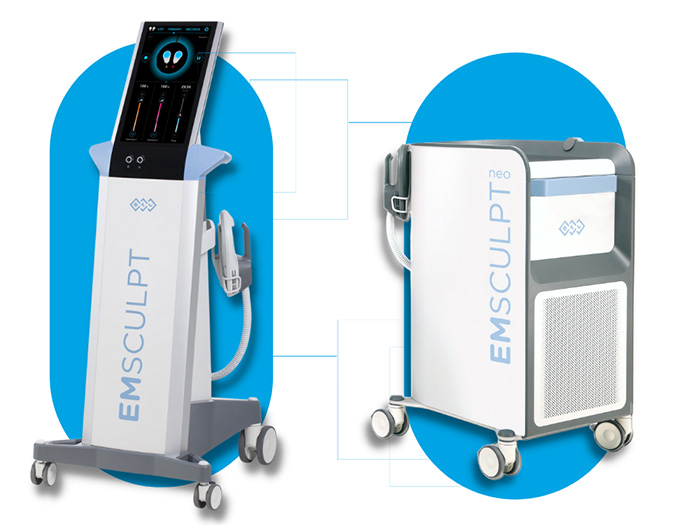
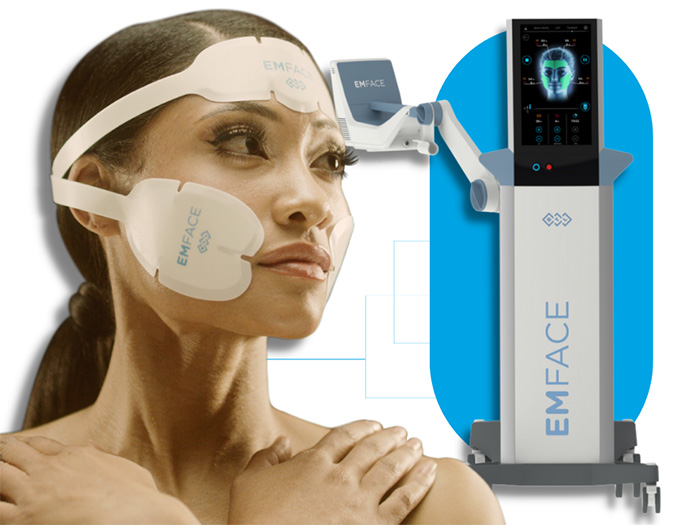
EMFACE
EMface is the leading non-surgical facelift. It relies on RF technology and HIFES to diminish wrinkles, trigger collagen production, and tone the face. There are no toxins and fillers, needles, or downtime involved. EMface can treat all face areas, including the eyes and brows, forehead, neck, and jawline.
EMSELLA
Emsella, also known as the ‘Kegel throne,’ is a non-invasive treatment that provides relief for people suffering from urinary incontinence. The device is an FDA-cleared ergonomic chair that uses HIFEM to penetrate the pelvic floor. It stimulates muscle contractions in the area while increasing vaginal laxity. In addition, it heals damaged tissues that support the pelvic region.
In just one 30-minute procedure, patients go through more than 11,000 supramaximal contractions! That is equivalent to 11,000 Kegels. Since it is a non-surgical procedure, there is no recovery time.
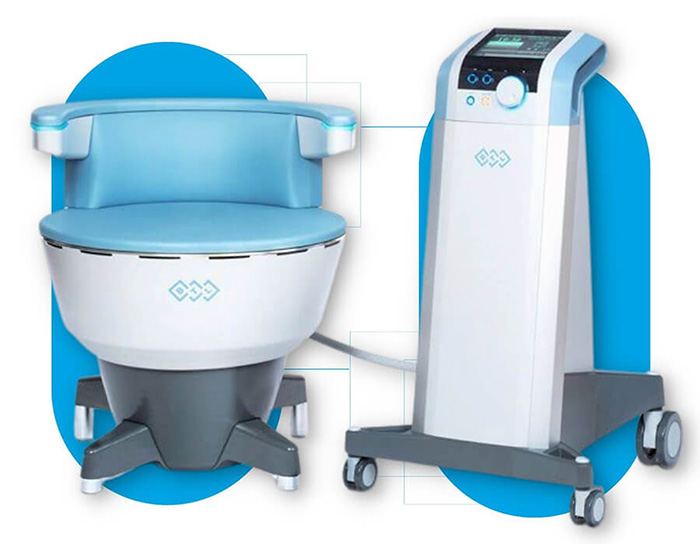
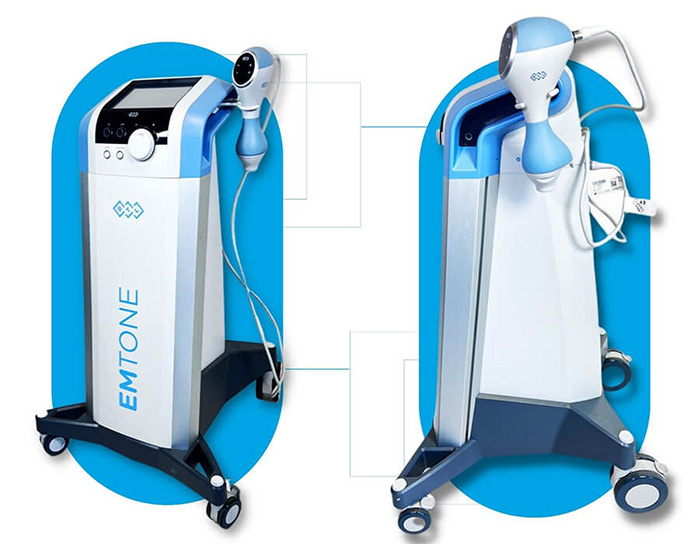
EMTONE
BTL’s Emtone is a revolutionary beauty treatment that targets and eliminates cellulite. The device works to smooth areas of the body that are prone to dimpled skin. This treatment combines two advanced technologies to tackle cellulite: radiofrequency (RF) energy and acoustic energy. Two energies penetrate the deepest layer of the dermis to uncover a rejuvenated appearance. Acoustic vibrations and thermal heating trigger the body’s therapeutic response.
Emtone works to encourage the production of elastin and collagen, which is essential for a healthy, youthful complexion. It also boosts circulation so that the body can eliminate metabolic waste build-up. The result is smoother, more radiant skin.
CELLUTONE
Cellutone is a non-invasive treatment that reduces cellulite and improves skin texture. The procedure relies on vibration to reveal tighter, younger-looking skin. Patients use this on their thighs, legs, arms, and buttocks. This beauty treatment is a fantastic option for those who want to improve their skin’s appearance without undergoing surgery.
The treatment method is simple. A technician places the device on the skin. From there, the vibration helps the body’s lymphatic system break down fatty deposits from within. This process encourages blood flow to the treatment site and in turn, reduces cellulite and smooths out the skin.
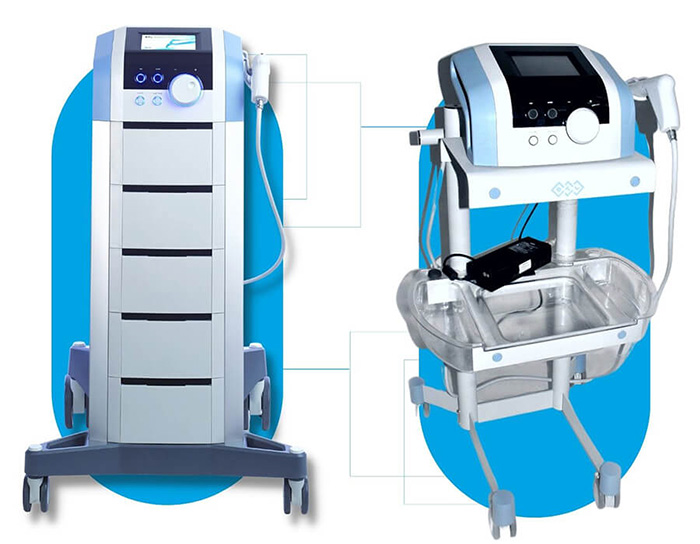
WEBSITE DESIGN AND DEVELOPMENT
A good website accomplishes three main objectives:

It provides a great user experience for its visitors
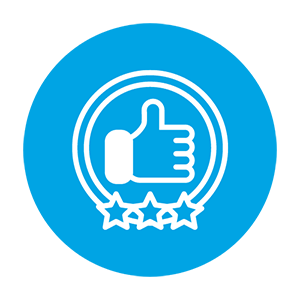
It establishes trust and consumer confidence

It makes it easy for the visitor to contact the business
IT'S ALL ABOUT USER EXPERIENCE (UX)
Optimized websites need a beautiful design and functional development. Focus the website's design and functionality on the user's experience. A good website exceeds the user's expectation for useful Information, flawless functionality, and ease of use. Websites that achieve this:
-
develop credibility
-
distinguish themselves from competitors
-
Invite users to contact your business or perform another desired call to action.
WEBSITE DEVELOPMENT AND DESIGN
“Website design and development” describes the process of making a website. “Design” refers to how the website looks and ease of use, and “Development” refers to how the website functions.
The Benefits of Good Website Design + Development
-
Increases online visibility
-
Attracts more customers
-
Distinguishes your brand
-
Engages and educates visitors
-
Provides value to the user
-
Generates free traffic with SEO
-
Increases contacts and conversions
DEVELOPMENT
If “design” is the beauty of your site, “development” is the brain. Professional website development is crucial for many reasons:
- Professional website development makes it easy for search algorithms to discover your website.
- Professional website development enables the user with flawless functionality.
- Professional website development is responsive across all devices. It is intuitive and engaging.
- Most importantly, Professional website development is user-friendly. It makes it as easy for visitors to contact you.
DESIGN
Once someone lands on your page, you have seconds to capture their interest. An eye-catching design and engaging layout should prioritize user experience above all else. The style and format should capture the attention of your online visitor. It should compel them to reach out to your business.
-
Page Loading Speed
The first five seconds of page-load time have the highest impact on conversion rates. Data shows that a website's conversion rate drops by 4.42% (on average) with each additional second of load time.
Google has used page loading time as a ranking factor since 2010. A good loading time is anything under 2 seconds. Slow web pages lose potential customers and negatively impact your google ranking.
How does your site loading time compare with other websites?
- if your site loads in 5 seconds, it is faster than approximately 25% of the web
- if your site loads in 2.9 seconds, it is faster than approximately 50% of the web
- if your site loads in 1.7 seconds, it is faster than approximately 75% of the web
- if your site loads in 0.8 seconds, it is faster than approximately 94% of the web
Check your page load speed here: https://pagespeed.web.dev/

-
Responsive Web Design
Responsive web design means your site looks and performs well on any computer, tablet, or phone device.
In 2020, 68.1% of all website visits occurred on a mobile device. Mobile users will leave websites not optimized for their devices. Furthermore, Google rewards websites with responsive web design and penalizes websites that don't.
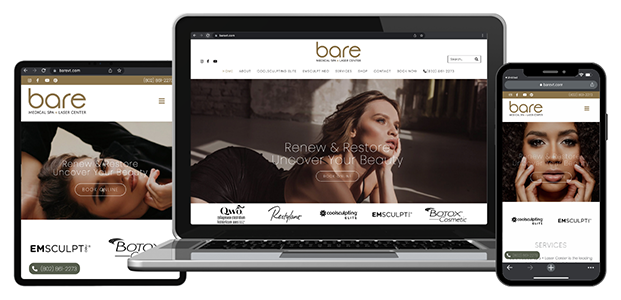
WEBSITE ASSETS
When marketing and selling BTL treatments, it can be tempting to focus all your efforts on the offering itself. But your website is just as much a part of your marketing efforts as your products are. That being said, your website must be designed to help consumers learn about you and to capture their contact information. This way, you can easily follow up with leads with the intent of turning them into customers.
Each BTL treatment provider’s website should include the fundamentals:
Landing Page: Show what you offer, a call-to-action above the fold, and a phone number where consumers can reach you.
Social Proof: Customers want to know that others have a good experience with you before investing money and trust. Testimonials and reviews help reassure them that they are making a good choice by choosing you.
Pop-up Window: Capture contact information from visitors before they move on with the rest of their browsing session. This prevents distractions and can drive up your conversion rate.
Lead Capture Forms: Make it a breeze for website visitors to get in touch with a user-friendly form that they can fill out with their personal information. Place lead capture forms above the fold.
Incentives: Give people a sense of urgency to become a customer by providing an exclusive deal. An enticing offer like $200 off your first Emsculpt session may be all it takes to convert someone “on the fence” into a patient.
Before and After Pictures: Online reviews and client testimonials tell people that BTL treatments work. But there is nothing better than seeing those transformations. When people are able to visualize the results they can get, they are more likely to feel they need the service, too. We suggest including at least two clear before and after pictures of patients that received the treatment at your practice.
Informative Content: Every website needs SEO-friendly content. It establishes trust, attracts organic traffic, and provides additional value to your audience. For example, if you sell Emsella treatments, you could have informative blog articles covering topics like “How Long Do Emsella Results Last?” or “Does an Emsella Chair Really Work?” When crafting these articles, be sure to incorporate relevant keywords like “Emsella Near Me” and “Emsella Benefits.”
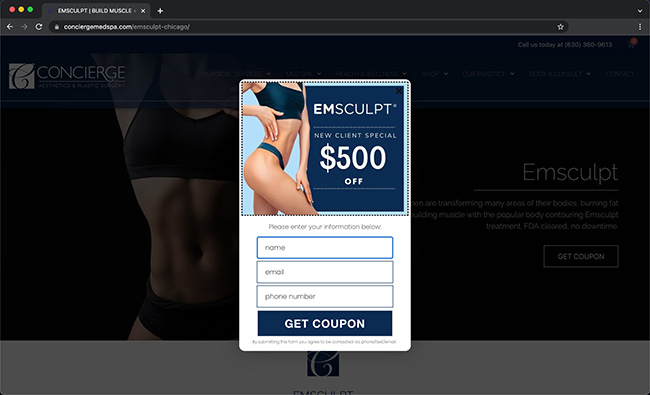
POP UP (LEAD CAPTURE TECHNOLOGY)
A strategically placed “pop-up” window can significantly increase your conversions. After integrating pop-ups on our client's websites, we saw a 400% to 500% increase in consult requests.
For an Emsculpt NEO popup, you can consider
LEAD CAPTURE FORMS
Optimized websites make it easy for the consumer to contact the provider. All vital Information–phone number, available promotion, and the contact form– should be above the “fold.”
- Tip: Collect the customer's Information first, then send them to a scheduling page.

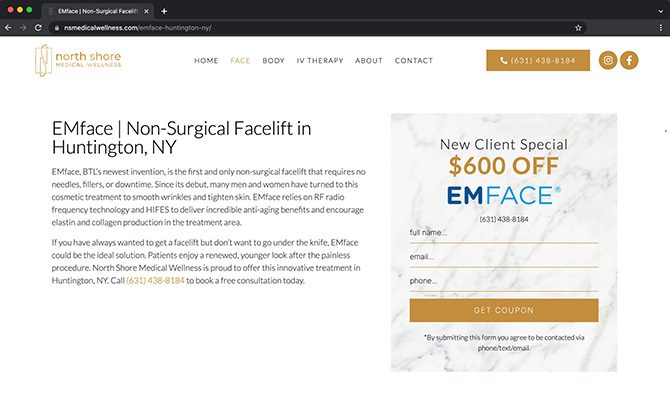
INCENTIVES
Consumers want to find an offer that provides value at the lowest cost possible. Adding a promotion or coupon to your website promotes both: a great value at a great price. For example, if you offer EMface for a non-invasive face lift, you could offer a coupon for $600 off a package of four treatments. This incentive encourages people to take action quickly if they have been thinking about getting EMface for a while.
BEFORE AND AFTER IMAGES
Before and after images, just like five-star reviews and client testimonials, establish authority and build trustworthiness. Moreover, consumers expect before and after images.
EMface is BTL’s newest aesthetic treatment. As people research more about the procedure online, they want to see what kind of results they can expect. Since it is a non-invasive facial toning solution, it is helpful to include before and after images of patients showing a more lifted and rejuvenated appearance following the treatment.
- TIP: Collect your own gallery of before and after images of your clients and post them to the website. If you don't have your own before and after images, use stock photos from the manufacturer.

CONTENT
There's a saying in digital marketing: Content is King. Your website needs content. Generating professionally written content does two things:
- Attracts organic traffic: Google awards websites that provide users with unique content about relevant topics. High Google rankings make your website more visible online and increase your flow of website visitors for free.
- Establishes trust: Well-written content demonstrates expertise on the topic. A good blog builds authority and distinguishes your brand from others.
- TIP: Remove content that you did not write yourself. Content cannot be pasted and copied from other websites. Google rewards unique content creation and penalizes plagiarism.
PAID ONLINE ADVERTISING
Paid Online Advertising, also known as paid media, uses paid ads to attract potential customers to visit your website or call your business.
WHY MARKET WITH ONLINE ADVERTISING
For most businesses, paid media is an important part of their online marketing strategy. Online advertising has three distinct advantages. It's fast. It's targeted. Its tracked.
- IMMEDIACY: PPC ads, banner ads, and social media ads make your business visible online almost immediately. They are the fastest way to improve your online presence and bring your website to the top of Google's first SERP.
- TARGETING: Paid ads are targeted to the people most likely to convert. TV, print, or billboard advertising targets a local audience. Online ads go further. They are directed to local consumers already showing interest in services your business offers, like Emsculpt, EMface, Emtone, Emsella, and Cellutone.
There are three main channels for online advertising:
- search engines
- websites
- social media platforms.
SEARCH ENGINES

Like television networks, such as ABC, NBC, or CBS, search engines generate revenue by selling ad spots. However, instead of commercials, search engines sell Pay Per Click (PPC) ads to businesses wishing to advertise on the search engine's results page (SERP).
Google, Bing, and Yahoo are examples of search engines that permit businesses to advertise on their SERP.
PPC AD PLACEMENT
Most search engines display PPC ads at the top and bottom of their SERP.
The more visible your ad is ( the higher your ad appears on the SERP,) the more likely the ad is to be clicked on. Having a PPC ad display at the top of the page is the equivalent of airing a commercial during prime time TV.
Unlike television, the prime ad spots on a SERP aren't purchased. They're earned. It costs just as much to display an ad at the top of Google's SERP page as it does at the bottom of the SERP page. Instead of charging higher prices for higher placements, search engines “rank” ads based on quality factors.
DISPLAY ADS / BANNER ADS
Display ads are also known as banner ads. Unlike PPC ads, which appear at the top of the SERP (Search engine results page), “display ads” appear on websites. These ads can be:
- Text ads
- Image/Graphic ads
- Video Ads
SOCIAL MEDIA ADVERTISING
Social Media Advertising attracts customers using paid ads on social media channels like Facebook, Instagram, and TikTok. Besides attracting leads, social media advertising can promote your business' brand and enhance your online visibility. In addition to ads, Facebook allows you to boost your posts.
The more visible your ad is ( the higher your ad appears on the SERP,) the more likely the ad is to be clicked on. Having a PPC ad display at the top of the page is the equivalent of airing a commercial during prime time TV.
Unlike television, the prime ad spots on a SERP aren't purchased. They're earned. It costs just as much to display an ad at the top of Google's SERP page as it does at the bottom of the SERP page. Instead of charging higher prices for higher placements, search engines “rank” ads based on quality factors.
TYPES OF FACEBOOK ADS
- Text Ads
- Image ads
- Video Ads
- Carousel Ads
- Product Ads
- Collection Ads
- Interactive ads
- Lead form Ads
ANALYTICS: PAID ADS ACCUMULATE DATA
Google provides businesses with valuable data. The longer your ads run, the more data you collect. This data, when properly analyzed, better optimizes your campaign. This generates more leads at lower costs.
Valuable metrics include:
- Click-Through Rates (CTR): When you advertise online, it is important to know how many people are clicking your ads. This is called a “click-through rate.” The higher your click-through rate, the better your ad is at convincing people to click on it. This means that you are spending less money and getting better results - which means you can afford to spend more money and get even better results! Determine your click-through rate by dividing how many ad impressions you have by the number of clicks you get.
- Cost Per Click (CPC): Most ads cost a certain amount of money per click your ad receives. The cost per click can vary depending on several factors:
- Your advertising platform. Google ads cost more than social media ads.
- The targeted keyword: Keywords that have a lot of competition (many businesses bidding on the keyword) than that keyword will cost more per click.)
- The time of day
- The number of advertisers bidding on these terms in your market
- Conversion Rate: A conversion rate is the percentage of visitors who take the desired action on your website, such as making a purchase or filling out a form. A good conversion rate can make all the difference in whether your campaign is successful. Determine your conversion rate by dividing the number of leads generated by the number of clicks on an ad. For example, if your ad gets 100 clicks, and 20 people sign up, then your lead-to-click ratio is 2%. Evaluating results is critical when it comes to conversion rates. If you are paying $10 per click for 100 clicks, but only generating 2% leads from those clicks, it may not be sustainable. You must focus on getting more leads from each dollar you spend on advertising to get the most value out of each individual lead.
AD MANAGEMENT
Ad management is a tricky aspect of medspa marketing. You want to get your message out there, but you also need to be smart about it. That means not wasting money on advertising if you do not have a clear strategy. Paid ads are expensive. This is why it is crucial to have a plan in place before you invest in paid advertising. The first step is to determine which platform will deliver the best ROI. To do this, track your advertising spend on different platforms back to revenue.
Here’s an example. Let’s say that you spend $1000 on Google and $1000 on Facebook Ads, but Google gives you 10x more leads than Facebook does. This piece of information tells you it is more lucrative for you to continue investing more in Google.
One thing that many advertisers struggle with is being patient. Investments take time to pay off, so do not expect an overnight ROI. Give the campaign a chance to reach people before writing it off as unsuccessful if you do not see results right away.
Finally, continual optimization is one of the most important aspects of ad management. You cannot simply set up a campaign and leave it to run on autopilot. You must continually analyze metrics and act accordingly:
- adjust budgets and days
- modify target audience(s)
- remove keywords that are not working
- incorporate the right zip codes
This prevents wasted spending on irrelevant clicks that do not convert into sales or leads.
SEO
WHAT IS SEARCH ENGINE OPTIMIZATION (SEO?)?
Search engine optimization (SEO) is marketing with search engines. It is the practice of optimizing your website to rank higher on Google's Search Engine's Results Page (SERP). Google reserves a section of its Search Engine Results Page (SERP) for organic listings. Websites with good SEO get their website listed in the organic listings section.
Unlike paid advertising, organic visibility cannot be bought. It must be earned. This is where SEO comes in.
WHY ORGANIC RANKING MATTERS
Search engine optimization (SEO) is arguably the most effective, durable, and economic strategy for generating online traffic (visitors to your website.)

Organic traffic is free
Organic clicks cost nothing. In comparison, paid advertising, also known as Pay Per Click (PPC,) costs money every time someone clicks on your ad.

Organic traffic converts.
Visitors that find your site via a search engine are typically further down the sales funnel than visitors who click on the first ad they see. Organic visitors are among the highest converting channels for website traffic.

SEO is durable
As long as your website is SEO optimized and your content is the best on the internet, your page will reign on the Search Engine Results Page (SERP). By improving your ranking in Google's organic results, you will:
BENEFITS OF SEO
-
Generate FREE traffic to your website
-
Improve online visibility
-
Establish brand awareness
-
Distinguish your business as an authority
-
Develop trust and consumer confidence
-
Educate and engage your customers
-
SEO has the best ROI
GOOGLE'S RANKING ALGORITHM
Google uses a proprietary algorithm to rank websites. This algorithm is kept secret to ensure impartiality, but Google has been straightforward about the main objective of its algorithm: user experience.
Google strives to be the #1 search engine. It aims to provide users with results that meet their needs, which is why the most relevant results show up first. When ranking websites, Google considers a few “ranking indicators”:
- fast loading speed
- backlinks to your website
- quality, informative content
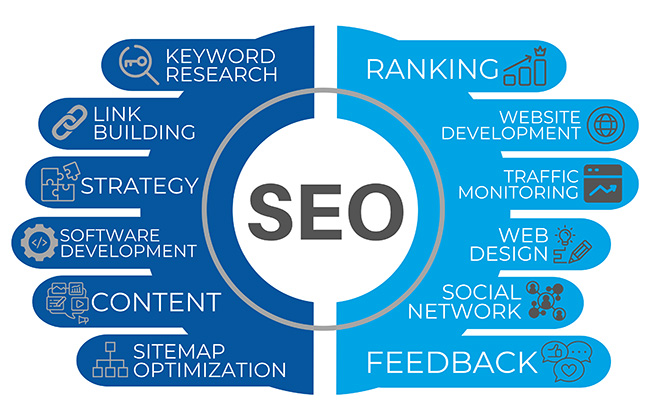
ON-PAGE SEO
-
1. Technical SEO
Google is focused on providing the best user experience for all. This is why they use robots and artificial intelligence to crawl websites and rank them according to their algorithm.
Technical SEO optimizes websites for search engine robots that “crawl” them. This ensures everything is in order so that the bots can read and interpret your website easily. Without technical SEO, your website may not rank as well.
-
2. UX User Experience (UX)
UX User Experience (UX) is important because it reflects how people feel about the products and services you offer. If they have a good experience, they will feel good about it and want to keep using it. But if they have a bad experience, they will be less likely to come back.
UX refers to everything that happens to your users when they interact with your business via your website or online communications. It includes everything people see, hear, and do, as well as their emotional reactions. The UX of your website directly affects a customer’s perception of your brand and its quality.
-
3. CONTENT
In the world of SEO, content is king. Quality content is essential for a high-ranking website. Google says content is one of its top 3 ranking factors.
“Content” refers to everything you put on your website for the user's consumption. It covers all the creative elements that are textual, audio, and/or visual. Content includes blog posts and articles, service descriptions, before and after images, videos, diagrams, charts, interactive media like quizzes, infographics, etc.
For your website to rank organically, it will need a lot of written content, videos, and images.
- Expert TIP: When creating a page that focuses on Emsculpt, optimize it with content such as:
- TEXT: Create a long-form page. Long-form means 1,000+ words of unique, well-written content.
- IMAGES: Before and after pictures (preferably your own)
- VIDEOS: Treatment videos or video testimonials
Writing Content for BTL Treatment Webpage
sEARCH ENGINES USE KEYWORDS
The top 10 most searched keywords for Emsculpt:
- “Emsculpt”
- “Emsculpt Neo”
- “Emsculpt near me”
- “Emsculpt cost”
- “Emsculpt Neo near me”
- “m sculpting”
- “Emsculpt NEO before and after”
- “Emsculpt price”
- “Emsculpt result”
- Emsculpt Neo cost”
Some of Emsella’s common keyword searches are:
- “Emsella”
- “Emsella reviews”
- “Emsella chair near me”
- “Emsella chair side effects”
- “Emsella cost”
- “Emsella for men”
- “Emsella for urinary incontinence”
- “Is Emsella covered by insurance”
- “Emsella for incontinence”
- “Emsella results”
The most popular keywords that people search for when Googling Emtone include:
- “Emtone”
- “Emtone near me”
- “Emtone side effects”
- “Emtone skin tightening”
- “Emtone results”
- “Emtone for cellulite”
- “Emtone cost”
- “Emtone before and after”
- “Emtone cellulite and skin tightening treatment”
When researching EMface, people type in the following keywords:
- “EMface”
- “BTL EMface”
- “BTL EMface before and after”
- “EMface non-invasive facial contouring”
- “EMface non-invasive facial treatment”
- “EMface facial toning treatment”
- “EMface cost”
READABILITY
You may be a doctor. But you can't write like one. Readability is fundamental to a good user experience. Therefore, readability is a factor Google uses in its ranking algorithm. Google rewards websites with writing that is understandable and easy to digest by its users.
Evaluate your readability using the “Flesch reading ease score.” The Flesch Reading Ease Formula is a simple approach to assessing the reader's comprehension by grade level. Your goal is to write at an 8th-grade reading level, or a score of 60 or above on the Flesch Reading Ease scale.
IMPROVE YOUR READABILITY SCORE BY:
-
Keep paragraphs short. Six sentences max.
-
Eliminate unnecessary words
-
Keep sentences short
-
Choose smaller words over bigger words
-
Write in active sentences
-
Use transitionary words to start new sentences
-
Limit a sentence to one idea
Learn more: https://yoast.com/flesch-reading-ease-score/
Many word processors will calculate your readability score. For example, on the right is the readability score this content received from the Microsoft Word editor:
Yoast, a plugin for WordPress, will also rank your readability. You can also copy and paste your content into a ranker that is free online, like https://readability-score.com/
For our clients, Medstar Media uses Microsoft word editor, Grammarly editor, and the Yoast Plugin on our WordPress sites to ensure our content has optimal “readability.”
SEO CONSIDERATIONS FOR DOCTORS and MEDICAL SPAS
Not all websites are ranked equally. According to Google, websites that promote products or services that impact the user's happiness, health, financial stability, or safety are held to a higher standard.
Google categorizes websites. Sites that promote products or services or provide Information that may impact the user's happiness, health, financial stability, or safety are categorized as YMYL. This stands for “your money, your life.” Websites belonging to spas, clinics, dentists, or other medical professionals fall into the YMYL category.
Google holds YMYL sites to a higher standard. The search engine uses a special algorithm for YMYL websites. The algorithm prioritizes “expertise, authority, and trustworthiness” (EAT).
This algorithm change for YMYL sites quickly became known as the “medic update” due to its impact on websites promoting health, medical, and aesthetic services.
expertise
Google wants to highlight content written by the industry's ” experts. ”
- **Expert Tip: Include author bios on your blogs. The author should be an "expert" on the topic. For example, an Emsculpt article should be written by a medical professional or skilled body contouring expert.
authority
Authority is a concept in search engine optimization that refers to the level of trust that a website has in the eyes of Google. When you have authority, you have an advantage over websites that are less authoritative. A website with high authority ranks higher in search results than one with low authority. Google has determined that the content on the high-ranking website is trustworthy enough to place it higher up on its list of search results.
There are various ways you can establish authority. Start by incorporating backlinks on your website, investing in quality content, and maintaining a consistent social media presence.
trustworthiness
To have a successful website, people have to trust it and the information it contains. The first step in establishing trustworthiness is making sure that all of your content is original and truthful. Build a relationship with your reader by providing them with useful information that helps them solve their problems or meet their needs. There are different ways to do this. One way is through original, high-quality blogs and articles. Learn what people are asking about and provide the answers in an engaging way. Though keywords are essential for search engine optimization, it is important to write for your readers first. Avoid keyword stuffing!
Finally, include an easy-to-follow privacy policy on your website. This way, visitors know exactly what will happen with their information if they submit it or subscribe to something. Be transparent about where all of this information will be stored. At the end of the day, people want to know that they are safe on your website.
SEO IS A LONG-TERM INVESTMENT
how long does it take to rank?
When it comes to SEO, the question “how long does it take for a website to rank?” is a common one. Unfortunately, there is no way of knowing how long things will take to rank – or even when a URL begins ranking on the Search Engine Results Page (SERP). This is because Google does not let us know how long things take. They do not want people manipulating their algorithms and rankings to get to the top.
SEO is not something you can get overnight, and there are no hard-and-fast rules on making a site rank sooner. But if you are consistent and invest in top-notch content, your website will eventually rank for the keywords that are most important to your business. Google recognizes quality and will rank you accordingly.
Once your website starts ranking, you must continually maintain it. SEO is not a one-and-done deal. Remember that trends change. Your keywords and content must keep reflecting these changing trends to keep your high ranking. Today, there are fantastic resources out there that can help you stay on top of keywords. For example, SEMRush tracks keyword trends and other important metrics. This information gives you a clear idea of where things stand at any given moment. From there, you can refresh your content to keep up with Google’s algorithm changes.
LOCAL SEO
LOCAL SEO stands for Local Search Engine Optimization. Local SEO makes you visible online to nearby consumers actively searching for aesthetic services.
46% of all Google searches have local intent. Almost half of all search queries will trigger local results on Google's Search Engine Results Page (SERP).
Local SEO is vital for small businesses looking to compete in the increasingly saturated aesthetics market.
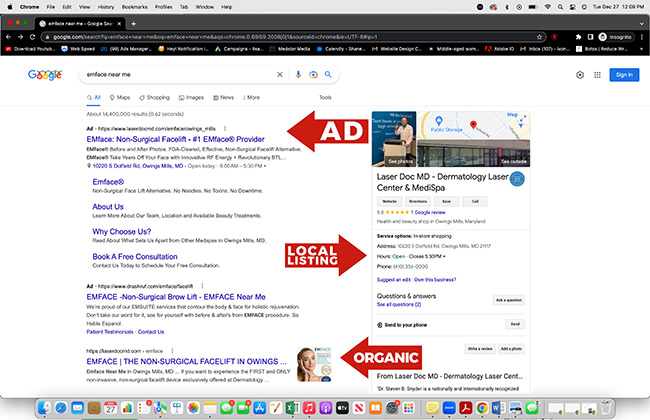
THE BENEFITS OF LOCAL SEO
-
Free online visibility
-
Connect with local consumers
-
Generate traffic to your website
-
Boost your brand
-
Rank high on the SERP
GOOGLE'S 3 TYPES OF LOCAL SEARCH RESULTS
To appear in Google's local search results, begin by completing your Google Business Profile (GBP). GBP is an online business directory. Google uses the Information provided on your Google Business Profile to generate three types of local results.
-
Google's local pack
-
Google maps
-
Google's SideBar (Knowledge Panel)
GOOGLE'S LOCAL 3-PACK
Google's local results appear in the “local pack” section on the SERP page. This section is located below the ads but above organic results.
The local pack, sometimes called “Google's 3-Pack,” displays three results. Each result is a different business listing.
The local pack appears when people search for a service or product using terms with location intent, i.e., “Botox near more.” Additionally, terms with a location in the query, i.e., “The Best Botox in Miami,” also render local results on the SERP.
The local pack appears 93% of the time for searches with local search intent. This kind of visibility matters! Brands that show up in Google's local 3-pack receive 700% more clicks than brands that don't.
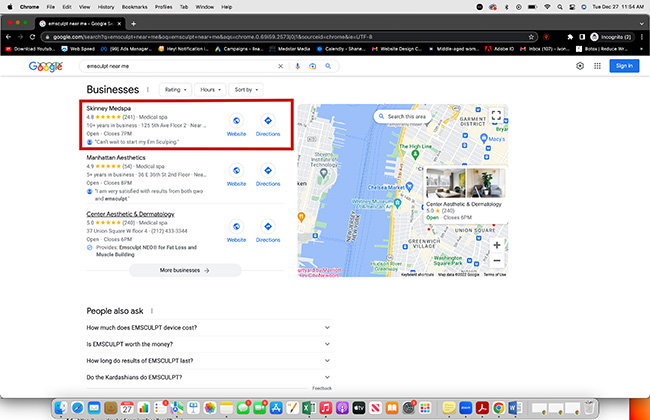

GOOGLE MAPS
Your Google Business listing integrates with Google Maps, the world's most popular online map and directions app.
Insights from local search data show local SEO garnered 32,000 views for one Medstar Media client during November in 2021.
Of those 32,000 views, two-thirds appeared in local search results. One-third appeared in Google Maps.
GOOGLE KNOWLEDGE PANEL
Google's knowledge panel, also known as the “knowledge graph,” is an information box that appears in the SERP.
The knowledge panel typically appears when someone makes a brand name search for your business.
The panel contains vital Information taken from your GMB listing. This includes your business address, phone number, business hours, reviews, website, and Q&A.
On desktop, the knowledge panel appears on the left-hand sidebar. On mobile, the knowledge panel typically appears below the ads.
HOW GOOGLE DETERMINES LOCAL RANKING
According to Google, “Local results are based primarily on relevance, proximity, and prominence.” Proximity is the biggest difference between local SEO and organic SEO.
Organic SEO is calibrated for a national or global audience. Organic rankings are based on prominence and relevance.
Local SEO narrows its results to the local geographic market the service provider resides in. Local rankings are based on prominence, relevance, and proximity.
-
Relevance
“Relevance” refers to how closely a business's services or products are related to a person's search query. Basically, does your business offer or sell what the customer is searching for?
Google derives “relevance” signals from:
- Website content
- Technical SEO like page speed and user design
- Information from the Google Business Profile
- Keywords and sentiment used in online reviews
By optimizing a brand for “relevance” signals, Google matches the right provider with the right consumer.
-
Proximity
Proximity is the main factor that distinguishes local SEO from Organic SEO. Proximity refers to the distance between the person performing the search and the physical business address.
Google typically knows a user's location. When a user searches using a computer, Google refers to the IP address. The IP address reveals the zip code the search is coming from.
When a user searches on their mobile phone, Google uses the phone's “geolocation.”
Google factors in the “user-to-business proximity.” The physically closer a user is to a business's address, the more likely the business will appear in local results.
Distance: Sometimes, Google considers a user's intent instead of their actual location. This typically occurs when a user includes the name of an actual location in their search query, i.e., “The best Emsella in Dallas.” The closer a business is to the location qualifier (“Dallas”), the more likely the business will appear in local results.
-
Prominence
Prominence refers to a business's reputation within the community. Basically, Google wants to list the aesthetic providers considered “the best in the business.”
Google draws upon online and offline Information to calculate a business' prominence. Influential Information may include:
- Listings in business directories
- Links and mentions to the business' website
- Domain Authority of a website
- The number of online reviews a business has
- The average rating of online reviews
- Google My Business (GMB) Listing
- Actual foot traffic to the business
Local SEO strategies focus on developing as many of these “prominence” signals as possible. Developing these signals helps Google trust your brand and distinguishes your business as a prominent authority for addressing someone's search query.
tIPS FOR LOCAL SEO
Local SEO is a great way for small business to increase their online visibility. Here are some tips for improving your local search engine optimization.
GOOGLE BUSINESS PROFILE
First and foremost, claim your business on Google and fill out a Google Business Profile (GBP). Google uses this information to generate its local search results.
LOCAL DIRECTORIES
List your business in local directories and review sites. Make sure your website is listed in industry-specific directories.
Medstar Media uses brightlocal to list and update our clients in online directories.
NAP (NAME, ADDRESS, PHONE NUMBER)
Your name, address, and phone number should be listed on your website. Many websites have their “NAP” in the footer (or bottom section of their website.)
Ensure that your NAP is consistent across your website and all other online listings. Use the same phrasing, spelling, and layout.
LOCAL BUSINESS SCHEMA
Local business schema refers to structured data markup code that you add to your website. This code provides search engines with useful information about your business.
GOOGLE BUSINESS PROFILE
Google Business Profile (GBP,) previously known as Google My Business (GMB), is an online business directory. Information provided on your GBP listing is used to generate results across several of Google's search results, including:
- Local Search
- Google Maps
- Google's sidebar
GBP IS FREE ADVERTISING
Google developed Google Business Profile to make it easier for users to get the information they need quickly and conveniently. GBP allows you to list, edit, and verify information about your business, including
-
Business name
-
Location
-
Phone Number
-
Hours of Operation
-
Website
-
Business description
-
Type of Business (category)
-
Services you offer
-
Available amenities
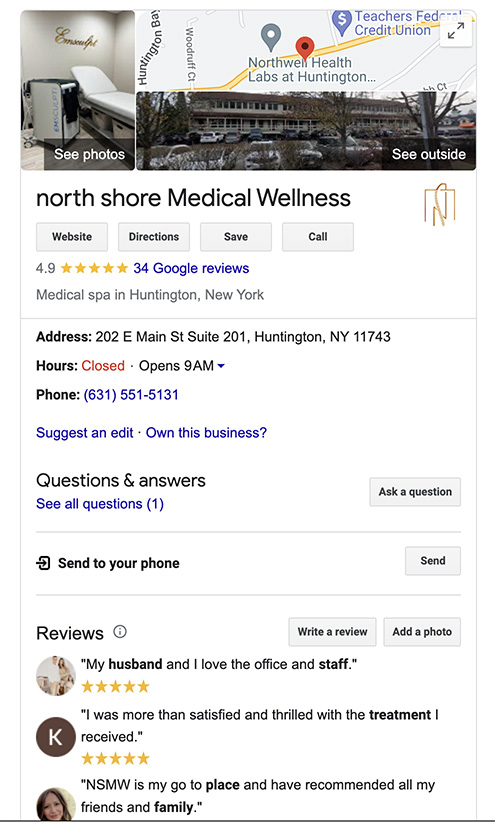
GOOGLE'S 3-PACK
Google's 3-Pack is a box containing three different GBP profiles. The box is positioned at the top of the Search Engine Results Page (SERP). The local pack appears when people search for a service, such as Emsculpt Neo using terms like “near more” or “Emsculpt” + location, i.e., “Emsculpt in NYC.”
Data suggests the Google 3-pack shows up in the first position on Google 93% of the time.
Brands listed on Google's local 3-pack receive a staggering 700% more clicks than brands that don't
GOOGLE MAPS
Your GBP listing integrates with Google Maps, the world's most popular online map and directions app.
GOOGLE KNOWLEDGE PANEL
Google's knowledge panel, also known as the knowledge graph or the sidebar, is a box that shows up on the right-hand side of the SERP. The knowledge panel appears when someone makes a brand name search for your business. The panel contains vital Information taken from your GBP listing. This includes your business address, phone number, business hours, reviews, a link to your website, and Q&A.
MARKETING TIPS FOR GBP
get a gbp listing:
Do it now if you have not filled out and certified your GBP listing. You cannot afford to miss out on this impression share (visibility).
optimize your listing:
If you have a verified GBP listing, take advantage of its opportunities for more exposure—upload photos and videos. Write a description of your business and the services you offer.
build out your q&A:
GBP has a question-answer feature. Use it. Submit your own questions (use questions that your customers most commonly ask you.) And then answer those questions.
REVIEWS
The importance of reviews for spas offering BTL treatments cannot be overstated. Reviews can give valuable insight into what you excel at and what you can improve on. When patients leave reviews, they are sharing their experiences with others. Asking patients to leave reviews shows that you value their opinion. Meanwhile, you can get ideas on how to keep offering a top-notch service or product.
Why are reviews so important? Let’s say someone living near your spa searches “Cellutone near me” on Google. If optimized correctly, your Yelp page will likely be one of the first results to show up. At this point, visitors want to see glowing and detailed 5-star reviews from satisfied patients. You get extra brownie points if those patients include their transformation pictures showing impressive cellulite reduction after getting Cellutone at your spa! Check all the boxes? New clients will more likely choose you over another facility with neutral or negative reviews.
Collect Reviews
Now that we have discussed the importance of reviews, let’s explore a few ways to gather them:
-
Ask patients to visit your website and leave a review.
-
Text patients requesting reviews on social media platforms like Facebook or Yelp.
-
Email your patients thanking them for their patronage, and then ask for feedback.
-
Make it easy for people to share their feedback by including links to Yelp and Google+ in your emails.
-
Place a sign on your establishment window inviting patients to share their insights on your preferred review sites.
-
Have paper surveys readily available at your front desk where patients can fill them out as they come in or leave the facility.
Manage Reviews and Maintain Good Relationships with Clients
Once you have gathered reviews from your patients, it’s time to manage them and maintain healthy relationships with your clients. Just like social media marketing, you must check on your reviews from time to time. Each time you get a positive review, keep the conversation going by writing a short thank-you and personalizing your message. Negative reviews can hurt, but they should not be ignored. You still have a chance at making things right with your customer. Write a thoughtful response apologizing for their underwhelming experience. Let them know the actions you are taking to fix the issue. When you post a public reply to a negative review, you show others that you proactively listen and take the necessary steps to resolve problems.
Optimize Your Facility’s Review Pages
Optimizing your online review pages is a smart way to get more eyeballs on your business. When doing so, make it easy for people to find what they are looking for, whether it is:
- patients’ before and after photos
- pictures or videos of the doctor in action
- information about your services
Having as much information and content as possible shows you are invested in building trust with potential clients. In addition to beefing up your online review pages with valuable content, it is essential to keep up with your customers’ reviews. Show appreciation for the positive ones, and offer to make things right for people who expressed they had a subpar experience.
SOCIAL MEDIA
Social media marketing is an integral part of any business strategy. It is no different for marketing popular BTL treatments like Emsculpt or EMface. Today, people spend a lot of time on platforms like Facebook, Instagram, and TikTok. These channels are free to use, and can help you build a strong online presence and establish your brand. When creating content for social media, there are two main types: organic and paid. Let’s take a look at how the two differ, yet work hand-in-hand to produce results.
Organic social posts are content you create and share in hopes of reaching an existing audience. If you are new to social media, this is a great place to start. Make consistent posts about your current promotions, or reach new clients by sharing links to your blog posts. A post about non-surgical facelift (EMface) or an introduction video featuring a specialist discussing Emsculpt while showing how it works will pique consumer’s interest.
Here are some unique EMface marketing social media post ideas:
- Infographics about EMface that outline the benefits, cost, and what a patient can expect if they choose this procedure over a surgical facelift
- Videos displaying behind-the-scenes of the non-surgical facelift in action
- Contests and surveys to engage your audience while getting feedback from them
- Short videos that teach people how to pick the best BTL treatment for them based on their needs
- Before and after images without revealing your patients’ personal information
Depending on what platform you are working with, your posts may differ. For example, Instagram is very visual. So, it is the perfect place to share before and after pictures of your EMface patients. People consume short-form videos on TikTok. If you have engaging videos showcasing how EMface works, they may do well on this platform.
Regardless of which platform you end up using most, remember that marketing on social media involves more than just posting. You must engage with your audience as well. This means answering questions when they come up, replying to direct messages, and more.
In addition to organic social posts, BTL treatment providers must leverage paid social ads if they want more traffic and immediate action. Similar to organic posts, paid social ads are content you create. The difference is that you pay the platform to reach a wider and targeted audience.
With the proper strategy, paid ads can be very effective. Providers must select the right platform, know their audience, and have a considerable budget. These days, video content has been getting incredible engagement. Knowing this, it would be wise to focus on video. But if you can, sprinkle in a few photos and infographics to keep things interesting.
Let’s say you are a leading provider of Emsculpt treatments in your area. Consider using videos showing the procedure being done on real people. A lot of times when people are on the fence about a beauty treatment, it is because they don’t know what to expect. In the case of Emsculpt, people may be wondering, “how is it possible to burn fat and build muscle at the same time?” Sharing content that demonstrates the process, impressive before and afters, and providing useful information about the treatment can turn Emsculpt leads into patients.
EMAIL MARKETING
The first marketing email was in 1978 and generated 13 million dollars in sales. More than 40 years later, email marketing is still alive and well. Email marketing seamlessly integrates with your other digital marketing strategies and is a highly effective channel for growing your business. Email campaigns allow you to engage with your existing customers and build relationships with leads by providing relevant, timely, and valuable information to help them act with your business.
WHY USE EMAIL MARKETING?
Along with your website's blog, email marketing provides one of the highest returns on investment (ROI) of any digital marketing channel. On average, email generates $38 for every dollar spent, a 3,800% return on investment.
LEAD NURTURING WITH PROSPECTIVE CUSTOMERS
Email marketing is a valuable lead nurturing tool. Email provides a great way to interact with website visitors that provided their Information when filling out a consult form but have yet to convert.
INTERACTING WITH EXISTING CUSTOMERS
A successful email campaign is one that gets your customers to click through to your website and convert. If you are not interacting with your existing customers and gathering their feedback, you are leaving money on the table. Interacting with your customers is a great way to see how they are responding to your emails and what kind of offers they like.
This information is crucial because it allows you to tailor your messages and offerings in the future. If people are not responding to a certain offer that you send out repeatedly, it might be time to change it up or consider other options.
The open rates of your emails show you how many people have seen them. Click-through rates from your email to your website tell you how many people have acted on them. They are particularly important because they show conversions, which is the purpose of your campaign. Observe details like which target segment(s) are converting what offers they are responding to. From there, you can weed out individuals who have not responded over an extended period of time.
Email list growth rate shows how fast your list is growing and provides insight into how much traffic is coming from each email campaign. There are two factors that influence the success of an email campaign: relevance and timeliness. Remember that while you may have a goal for your campaign, people are focused on what they can get out of it. The goal is to offer a relevant product or service to the right person at the right time.
TYPES OF EMAILS
EMAIL MARKETING TIPS FOR BTL TREATMENT PROVIDERS:
The highest converting emails contain one or more of the following:
- Answers to frequently asked questions
- before and after images
- Real patient testimonials,
- Specials or incentives
An email marketing provider (ESP) is a great resource if you're looking for any level of support while fine-tuning your email marketing efforts.
CONTENT THAT CONVERTS
Effective emails have:
- Strong subject lines which entice people to open and read your message
- A concise message with helpful information
- Links to your website or blog
- Compelling calls-to-action
- Addressed from a real person, not company names like “Body Sculpting Center of New England.”
ECOMMERCE
HOW DO ECOMMERCE PLATFORMS WORK?
Ecommerce platforms, such as WooCommerce or Shopify, allow customers to pre-buy services before coming into your spa or clinic for a consultation and treatment.
These platforms can be integrated into your website, allowing you to pre-sale treatments online.
SELL NOW. CONSULT AND TREAT LATER
Consumer buying habits are changing. More people are buying online, and many are making more impulse purchases. Ecommerce platforms are essential for staying at the forefront of your industry in the digital age.
We've seen ecommerce platforms really deliver for many of our clients.
For example, SKINNEY Medspa promoted a black Friday sale. It sold over $100,000 in CoolSculpting cycles in just five days using an ecommerce platform. SKINNEY didn't speak to a single customer or conduct a consultation to secure these transactions, and it all happened online.
Their customers bought CoolSculpting packages through Shopify and then went into SKINNEY Medspa to receive their consultation and treatment. Some consumers bought too few cycles. SKINNEY up-sold them during the consult. Some consumers bought too many cycles. SKINNEY credited their client's account.
LEAD NURTURING
You know that EMface leads are people who have shown interest in getting a facelift without surgery. They are likely to become customers, but may want more information before making the investment. So what do you do with these leads? How can you turn them into paying customers? The answer is simple: nurture them.
Lead nurturing is a process by which you communicate with your leads over time, helping them along their path toward becoming a patient. As an EMface provider, it is your job to find out what your leads are looking for, and deliver just that.
You can nurture your leads in many different ways. Most providers rely on emails, texts, and/or phone calls. It is always a good idea to be proactive and ask consumers what they prefer. But no matter how you choose to communicate with your leads, the goal is always the same. Get them excited about EMface!
We have found that emails are rarely responded to. Sometimes, they get filtered out into the spam folder. Other times, people read emails but forget to respond (or simply don’t feel compelled to). Today, many of us prefer texts because we are always on our phones, but may not be able to talk. Texts allow us to get back to people later when it is more convenient. Phone calls can be hit or miss, but they have their advantages. Some leads like the extra human element to this form of communication. It helps build trust and can make you seem more personable.
Regardless of the communication method, the key is to find out what works best and stick with it.
FRONT DESK TRAINING
You may be a doctor with an impressive resume, a seasoned business owner, or a highly trained aesthetician. Regardless of the staff member’s paygrade or prestige, the most important staff member in your entire Emsculpt operation is the person answering the phone.
Your front desk receptionist is the first line of contact with a potential customer. They make or break the deal. Your marketing efforts will mean nothing if you cannot secure the leads that are generated online.
Proper front desk training is an integral, yet often ignored, part of successfully selling Emsculpt or Emsculpt NEO treatments. Improving your front desk and lead nurturing practices is one of the best ways to book more consultations and sell more treatments.
Furthermore, improving your front desk practices will decrease no-shows, set the customers' expectations for the consultation, upsell more, and make you more money overall.
ANSWERING THE PHONE
The person who answers the phone is the spokesperson for your business. They impart the first impression a potential customer has with your business.
Front desk receptionists have three main objectives when answering a call about BTL treatments. And while these three things are simple, mastering these objectives takes training, practice, and expertise. In the following breakdown, we focus on Emsculpt treatments, but the concept applies to Emtone, Emsella, and EMface as well.
THE 3 OBJECTIVES WHEN ANSWERING AN EMSCULPT CALL
-
Educate and answer questions
- Every receptionist needs to develop a 15-second sales pitch about Emsculpt. The sales pitch needs to explain what Emsculpt is and why people love it.
- The best way to answer a caller's questions about the treatment or expected results is with personal experience.
- Remember: the call is not the consultation. Front desk receptionists should not determine treatment parameters or a caller's candidacy for the Emsculpt treatment.
-
Excite
A front desk receptionist should be passionate about the Emsculpt treatment. Excitement is contagious, and it's important to get the caller excited. Incorporating personal experiences is a great way to genuinely express why you are so excited about Emsculpt or Emsculpt NEO.
- Talk about the great results you've seen yourself from the Emsculpt treatment or the great results you've personally seen with other patients.
- The receptionist is not just selling Emsculpt; they are selling your business. They should express why your practice is the best choice for Emsculpt treatments in the area.
- Along with your Emsculpt elevator pitch, develop a pitch on practice uniqueness.)
-
Book a Consultation
This is the ultimate objective of the front desk receptionist.
- TIPS FOR EXCELLENT CUSTOMER SERVICE OVER THE PHONE
- Use "verbal nods" like "Mhm" or "Ah yes, I understand." Your body language translates over the phone.
- Use plain language. Stay away from jargon, technical terms, and acronyms. Be professional, concise, and clear.
- Get your customer's name and then use it in your conversation. Dale Carnegie said, "Remember that a person's name is to that person the sweetest and most important sound in any language."
- Validate your caller's questions or concerns, i.e., "That is a good question," "that is a common concern," etc.
- Know your stuff. Be knowledgeable about the treatments callers may inquire about
- Share personal experience
- Avoid Yes or No questions. Instead, use assumptive phrases and questions
- REQUIREMENTS FOR ANSWERING THE PHONE
Anyone answering the phone should be able to:
- Successfully field an Emsculpt inquiry.
- Book an Emsculpt consultation.
- Answer questions about the Emsculpt treatment.
If a staff member does not know about Emsculpt nor how to engage a caller and book a consultation properly, they should not answer the phone. This may require that all staff know the proper protocol for answering Emsculpt inquiries.
DISCUSSING COST
However, it is very hard to estimate a cost when discussing personalized treatments, like Emsculpt.
When someone asks how much a treatment costs, try to redirect them towards scheduling a consultation. If they inquire again or are persistent, consider providing a rough estimate. Remember, many callers are price shopping. If you refuse to provide a ballpark figure for them, they may completely move on from your business.
Provide an estimate by taking the lowest possible cost of a single Emsculpt treatment and say, “treatments start at $[amount]. However, Emsculpt is a highly customizable treatment. The only way to get a personalized quote is by meeting with a treatment specialist who can tailor a treatment plan that matches your needs and meets your budget.” Then discuss anyway a person can save on treatment costs, like specials, incentives, etc. Also, mention any financing options your business may provide.
PERSONAL EXPERIENCE: AN INVESTMENT THAT MAKES A LOT OF DIFFERENCE
Anyone playing a role in your Emsculpt sales funnel should undergo an Emsculpt. This is especially important for front desk receptionists who must share excitement and experiences with callers inquiring about Emsculpt.
Answering the caller's questions with personal experience:
- makes the call sound more genuine,
- endorses the Emsculpt procedure,
- helps develop a connection with the caller,
- allows the person answering the phone to express passion for the treatment.
4 THINGS YOUR SALES STAFF SHOULD KNOW BY HEART
-
1. Emsculpt elevator pitch: a brief statement on what Emsculpt is and why it is popular. This statement should be one to two sentences or 15 seconds long.
-
2. Uniqueness statement. Why is your spa or practice unique? Why should someone choose your facility over the competition? This statement should be one to two sentences or 15 seconds long.
-
3. Answers to frequently asked questions
-
4. The Emsculpt call script and front desk best practices.
RESPONSE TIMES
According to an MIT study, response times significantly affect conversion rates:
*4X less effective by waiting 10 minutes
placing a caller on hold
Being placed on hold for too long, or put on hold instantly, is a major reason callers hang up or decline to book a consultation.
If you have to put a caller on hold, first get the caller's name and purpose for calling. Then ask permission to place the caller on hold.
For example:
Receptionist: Hello. Thank you for calling Medstar Medspa. My name is Whitney. May I ask with whom I am speaking?
Caller: My name is Chris. I am calling about CoolSculpting
Receptionist: Hello Chris. You're interested in CoolSculpting. That's fantastic! May I ask you to hold for a brief moment? I have another caller on the opposite line.
Caller: Yes
Wait until they answer yes before placing them on hold. If the caller has to be on hold for a long time, get their information and call them back.
SECRET SHOPPER
Secret Shopping audits how staff handle leads and communicate with potential patients. The process evaluates:
Response time: The “secret shopper” submits a lead on the client's website and monitors how long it takes to get a response from the business.
Engagement: The secret shopper tracks the number of calls and texts received from the business after submitting a lead. This determines how well staff pursues a potential patient once they submit a lead. Remember, today's culture rewards instant gratification. Customers connect with the business that contacts them the quickest. If leads are not followed up with text messages and phone calls, potential patients will look into another spa.
Interaction: The process also includes initiating text interaction and measuring how the practice responds to questions from potential leads.
Communication: The final step of the secret shopping process is to get on the phone with the front desk staff. The secret shopper calls the business and asks about a treatment, like Emsculpt NEO.
Secret Shopping aims to evaluate how well a practice responds to a lead and how likely they are to close the sale.
At Medstar Media, we provide “secret shopper” services. Our top “lead nurturing” instructor calls our client's practice pretending to be a potential customer.
For example, Our secret shopper calls a provider about the Emsculpt treatment. The caller explains that she is getting married and struggles with stubborn fat. This scenario allows the receptionist to build rapport with the caller by asking about the upcoming event. We evaluate the receptionist's friendliness and helpfulness.
To perform a successful secret shop, we ask questions just as if we were shopping for a product we do not know about. Examples of questions include: Does it hurt? What is the downtime like? When will I see the results? How much does it cost? How well does it work? The entire conversation is recorded.
Secret Shopping is intended to illustrate where a practice needs to improve its lead nurturing to convert more leads into patients. It ultimately helps businesses improve customer acquisition. The secret shop reveals both what the practice must improve upon and where it is excelling.
The recorded call measures:
- the ability to establish rapport
- personality
- sales tactics
- the guidance provided to the consumer
- knowledge & expertise
The point to keep in mind is that even though marketing has the potential to bring a practice an influx of leads, it is ultimately up to the practice's staff to convince a prospective customer that the practice and the treatment they offer are worthy of the lead's time and money.
INCENTIVIZING STAFF
improving lead management and motivating staff with metrics
Successful Customer Acquisition Management (CAM) requires collaboration. As your marketing firm, we're responsible for generating high-quality leads. You and your staff are responsible for nurturing and converting those leads.
Measuring and tracking these leads is essential.
measuring leads and staff performance
Metrics do more than measure. Metrics motivate. Have your staff measure and report their performance metrics each week.
weekly reporting
Reporting should be performed every week. However, keep the metrics simple. Each week, staff members report the number of consults they performed and their revenue from each consult. From these two data sets, calculate the average Dollar Per Consult (DPC.) The DPC is the motivating metric.
making it fun
You can up the ante with games, challenges, or prizes for the staff member(s) with the best DPC. However, simply reporting these metrics weekly is motivating in and of itself.
Staff may also report “wins and challenges for even better insight into your sales.” “Wins” recognize the staff member for their achievements during the previous week. “Challenges” identify elements that obstruct conversions.
Knowing your staff challenges helps you and us. For example, suppose your staff reports that too many potential leads lack the money to purchase your services. In that case, we can use that Information to adjust on our end.
FINDING A DIGITAL MARKETING AGENCY
Become a dominant competitor in the BTL treatment marketing industry. Take the first step by scheduling a complimentary consultation with Medstar Media. Fill out the online form below, email us at support@medstarmedia.com or call (801) 877-1744 today.
SOURCES
Aesthetic Medicine Market Size, Share & Trends Analysis Report by Procedure Type (Invasive Procedures, Non-invasive Procedures), By Region (North America, Europe, APAC, LATAM, MEA), And Segment Forecasts, 2022 – 2030. Published Jan, 2022. Grand View Research. LINK.
AESTHETIC PLASTIC SURGERY NATIONAL DATABANK STATISTICS 2019. Aesthetic Society. LINK.
SCHEDULE A BTL TREATMENT
MARKETING STRATEGY SESSION
*By submitting this form, you consent to receive automated marketing calls, texts, and emails from Medstar Media. Consent is not a condition of purchase. Reply ‘STOP’ to opt out.

SOCIAL PROOF
Social proof is a powerful tool when it comes to building credibility and trust. It is a psychological phenomenon in which people are more likely to do something if they see that other people are doing it. Social proof is crucial if you are trying to convince someone that something is worth their time and money – like a BTL treatment.
Think about it: If someone sees a lot of people getting Emtone or Emsculpt NEO at your facility, that person is more likely to keep you in mind for those services when they need them. This leads us to our next point – positive reviews and testimonials.
Establishing authority and trustworthiness online is essential, especially when competing in a saturated market. A great way to accomplish this is by posting client testimonials and online reviews on your website.
Online reviews and client testimonials are a primary resource for consumers when choosing where to shop locally.
Almost 9 in 10 consumers consider an online review as important as a personal recommendation. In addition, 93% of consumers say that online reviews influence their purchase decisions.